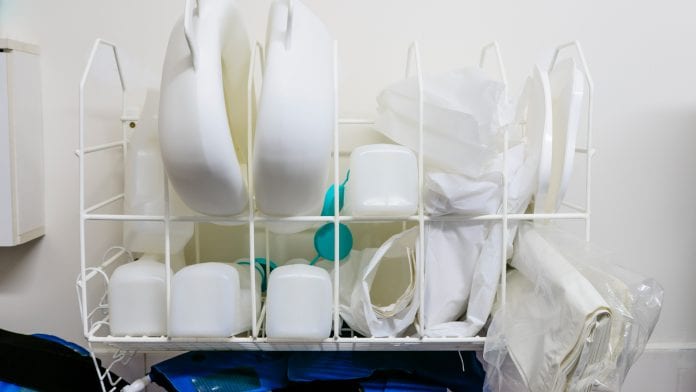
HEQ explores cleaning protocols for communal care equipment.
Much of the focus of infection control reporting has been on the public-facing areas of hospitals and clinical settings, with discussion and analysis honing in on issues such as surface cleaning, the use and sterilisation of personal protective equipment (PPE), and the role of technology in averting the spread of disease. Just as important, however, is the unseen work behind the scenes, ensuring a rapid turnover of clean, disinfected care equipment. Reusable, non-invasive care items – also known as ‘communal’ equipment – include beds and mattresses, as well as bedpans and commodes; and the continuous decontamination of these communal items is imperative for the maintenance of a clean, safe healthcare environment.
Cleaning and disinfecting equipment
In a 2019 Nursing Times article titled ‘Infection control 1: decontamination of non-invasive shared equipment’, Neil Wigglesworth, Director, Infection Prevention and Control at Guy’s and St Thomas’ Foundation Trust, identified three distinct levels of care equipment decontamination:
- ‘Cleaning – thorough cleaning with water and a neutral detergent or disposable detergent wipes to remove substances such as dust, soiling and organic matter, along with a large proportion of micro-organisms – the first and most important step in any decontamination process (Public Health Agency, 2011);
- ‘Disinfection – use of heat or chemicals after cleaning items known to be/suspected of being: contaminated with blood and/or body fluids; in contact with mucous membranes; used by a patient with a known/suspected infection or colonisation with organisms such as C difficile and multidrug-resistant bacteria, as specified in local protocols (Health Protection Scotland, 2015), to reduce the number of viable micro-organisms to a level that is not harmful to health; [and]
- ‘Sterilisation – use of heat (some chemicals may sterilise in specific, highly controlled systems) to render objects free from viable micro-organisms, including bacterial spores and viruses (used to decontaminate high-risk items including reusable invasive equipment such as surgical instruments).’
Wigglesworth further recommended the use of enhanced cleaning procedures at least twice daily during outbreaks of infection or disease.
Manual cleaning and risk
Due to a combination of limited resources and a lack of logistical prioritisation at the procurement level, staff in many hospitals are still compelled to clean bedpans and commodes by hand; despite the myriad of warewashing machines commercially available for this specific purpose. In the absolute best case scenario, this still represents a potential impact on staff morale and wellbeing – in the worst case, it accelerates the spread of disease.
Manual washing and disinfection of communal utensils consumes staffing hours which could reasonably be spent on clinical work; and can be actively harmful to staff in a number of ways:
- Hazardous biological waste may attach to their skin and clothing through ‘splashback’, necessitating a change of clothing and the potential need for testing and prophylactic medication, if the patient is infectious;
- Waste particles may be aerosolised by the high pressure equipment used to clean bedpans and commodes manually: aerosolised microbes can then infect the staff member or the cleaning room itself; and
- It is effectively impossible to clean equipment by hand at 80°C, the recommended temperature to kill the pathogens present in human waste. This means that it is almost inevitable that some bacteria or microbes will remain on the equipment, which in turn means the worker could become a vector for infection, passing on the disease to colleagues, patients and family members.
Automated cleaning
By comparison, washer disinfector machines are superior in virtually every sense: most significantly, in their capacity to clean equipment at the recommended temperature of 80°C or above, thereby killing or denaturing 99.99% of relevant bacteria. Automated cleaning processes factor out the risk of human error – manual disinfection procedures in hospital wards only result in fully comprehensive decontamination around 50% of the time – and the contained nature of washer disinfectors means that there is no risk of splashback onto an employee’s skin or clothing. Similarly, any waste particles which are aerosolised during the cleaning process are immediately denatured by the ambient heat within the machine and then flushed away at the end of the cycle. Hands-free washer disinfector models are also available, further reducing the risk of infection spread.
From a sustainability perspective machine cleaning minimises the wastage of water, as multiple utensils can be cleaned in a single load; and the machine disposes of used water quickly and efficiently, minimising the risk of exposure to contamination. Smaller models can be installed in individual patient rooms, eliminating the need to transport contaminated utensils through clinical environments.
This article is from issue 14 of Health Europa. Click here to get your free subscription today.
























